Last Updated on April 13, 2025 by Owen McGab Enaohwo
![How To Create a Project Management SOP [+Tips From Project Managers]](https://www.sweetprocess.com/wp-content/uploads/2025/03/sop-for-project-management.png)
You just landed a major client, an exciting opportunity that could take your business to the next level. With this new development, your team is motivated, and everyone is eager to deliver outstanding results. But as the project moves forward, you realize that without proper structure, coordination becomes difficult, communication breaks down, and inefficiencies pile up.
Task ownership is unclear, team members start doing duplicate work, and you miss all the deadlines. By the time the project is delivered, you’ve spent a lot of resources dealing with frustrations and unnecessary mistakes.
Now, imagine running that same project with structured, standard operating procedures (SOP) in place. From day one, roles and responsibilities are clearly defined. Each step of the process is documented, ensuring that tasks flow smoothly and communication stays transparent. SOPs outline clear, repeatable steps for every stage of a project.
SOPs aren’t just checklists. They’re your business’s best bet if you want to streamline your project workflows and have better outcomes. This guide will show you how to create effective SOPs for project management, plus ready-to-use templates and examples to help you get started.
SweetProcess makes it easy to create, document, and manage SOPs so your team can work smarter. Sign up for SweetProcess today and start optimizing your project management processes!
Table of Contents
Why Are SOPs Important in Project Management?
How To Create an SOP for Project Management: A Step-by-Step Guide
How To Create and Manage Your Project Management SOPs With SweetProcess
10 Project Management SOP Templates & Examples To Inspire Your Team
Best Practices & Tips for Creating and Adopting a Productive Project Management SOP
Create and Manage Your Project SOPs in One Place
What Is an SOP?

A standard operating procedure (SOP) is a comprehensive set of step-by-step instructions that outlines how to complete a specific task or process within a business. Implementing SOPs in your business ensures consistency, efficiency, and compliance since you have clear guidelines that employees should follow to reduce the risk of errors and miscommunication.
In project management, SOPs define everything from task assignments to progress tracking and reporting. They help standardize processes, making it easier for teams to collaborate and maintain quality standards. Well-crafted SOPs keep projects running smoothly.
Why Are SOPs Important in Project Management?

Have you ever wondered why some projects run smoothly while others are affected by delays and confusion? You might be missing the proper SOPs. These guidelines provide a solid foundation for an efficient and scalable project management process.
Let’s look at why SOPs are essential for your project:
Training and Onboarding
If no standardized process exists for bringing new team members up to speed, it can be time-consuming and inconsistent. Statistics show that 50% of hourly employees leave their jobs within the first four months due to factors like poor onboarding.
Your company will encounter such issues if you don’t have clear guidelines that employees can rely on as they start their roles within a project.
SOPs streamline the training and onboarding process by providing step-by-step instructions for project tasks, reducing the learning curve for new hires. New employees can quickly understand workflows, expectations, and best practices, allowing them to contribute faster.
Efficiency
Are your projects frequently delayed due to miscommunication or rework? A lack of standardized procedures is often the culprit, leading to wasted time and resources. This is where an SOP Manual becomes indispensable.
By implementing a comprehensive SOP Manual, you eliminate guesswork and establish clear, repeatable processes for task completion. It ensures that every project adheres to a proven workflow, minimizing delays and significantly improving overall efficiency.
With standardized procedures in place, teams can focus on execution rather than troubleshooting, driving consistent results and productivity.
Team Collaboration

When team members operate in silos, projects suffer. For instance, if the marketing and sales departments are working on a project and the team members don’t have clarity on task ownership, there will be communication gaps and differing work styles that can create bottlenecks.
However, with SOPs, you have a shared knowledge base that keeps everyone on the same page. You can:
- Clarify responsibilities
- Standardize reporting structures
- Ensure smooth handoffs between departments
Once employees understand their goals, they can collaborate and meet the project’s deadlines.
Consistency
Consistency in project management is crucial for ensuring quality across different teams, clients, and timelines. Without standardized procedures, organizations may face varied outcomes, leading to inefficiencies and confusion. Implementing Standard Operating Procedures (SOPs) is a key strategy to address these challenges.
SOPs provide a framework that ensures tasks are completed uniformly, regardless of who is assigned to them. This consistency is especially vital for companies looking to scale their operations, as it helps maintain quality and efficiency during growth phases. To effectively create and implement SOPs, following SOP Best Practices can significantly enhance their effectiveness.
Documentation and Knowledge Capture
What happens when a key team member leaves during a project? Does the project continue smoothly or stall?
If critical knowledge isn’t documented, the company risks losing valuable expertise. SOPs act as a central knowledge repository, preserving institutional knowledge and making it accessible to everyone. Your team can retain critical information when employees transition. Additionally, your new hires have a reference point when working on a new project.
Regulatory Compliance
Failing to comply with industry regulations can result in hefty fines and reputational damage.
SOPs help businesses maintain compliance by providing documented procedures that align with industry standards. Whether you need to meet OSHA, GDPR, or ISO requirements, SOPs provide the necessary framework to ensure you avoid penalties.
How To Create an SOP for Project Management: A Step-by-Step Guide
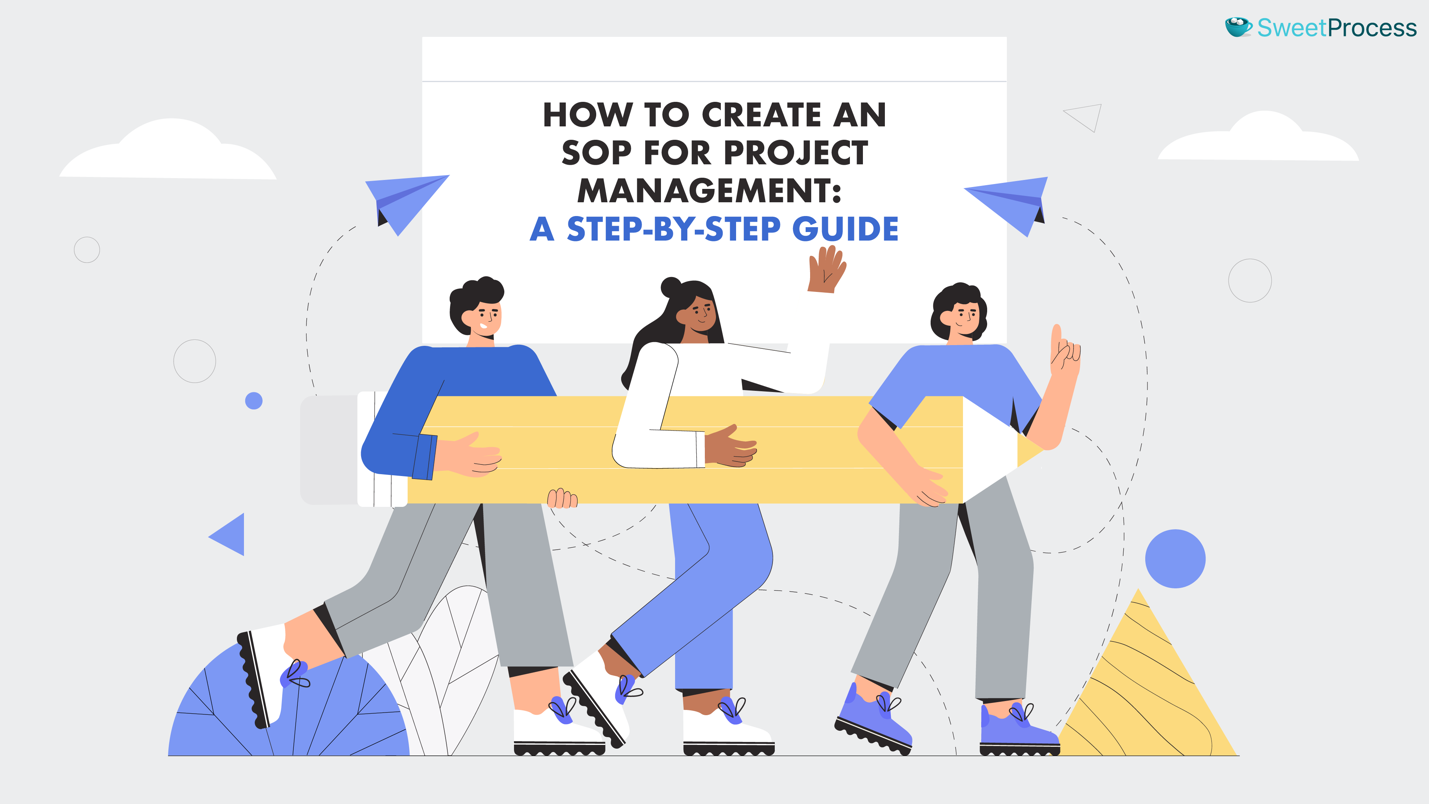
Creating an SOP for project management is about building a structured, repeatable system that keeps projects on track and ensures seamless execution. This is the difference between meeting your deadline and dealing with last-minute chaos.
But it doesn’t have to be this complex.
Follow these eight essential steps to create an SOP that streamlines your project management processes:
Step 1: Identify Your Audience and Determine Your Project Goals
Before creating your project management SOPs, ask yourself:
- Who will be using this SOP?
- Are you writing it for project managers, team members, or external stakeholders?
Defining your audience is the first step in creating a practical and actionable SOP.
Once you identify your audience, outline the specific goals of the SOP. To determine this, you can examine:
- The problems that this SOP will solve
- How it will improve project efficiency
- The key challenges your team currently faces in project execution
For instance, if you’re managing software development projects, your SOP document should cover key phases like sprint planning, backlog refinement, and quality assurance testing. If it’s for marketing campaigns, the SOP should guide tasks like content creation, approval processes, and performance tracking.
The clearer your audience and goals, the more effective your SOP will be in achieving project success.
Step 2: Assemble Your Project Team
No project is executed in isolation. Every successful SOP needs input from key stakeholders, including project managers, team leads, and subject matter experts. For the best results:
- Identify key contributors: These are the people responsible for executing different parts of the project.
- Define roles and responsibilities: Who oversees approvals? Who tracks deadlines? Who provides feedback?
- Encourage collaboration: A well-rounded SOP reflects real-world project execution, not just theoretical guidelines.
By involving the right people early, you create a document that is practical, realistic, and easy to follow.
Step 3: Gather All Necessary Information

Before drafting your SOP, compile all relevant information about how your project is typically managed. This includes:
- Current workflows and bottlenecks
- Tools and software used
- Best practices and industry standards
- Compliance or regulatory requirements
You can also look at past project reports, interview team members, and review existing documentation for more information. The more comprehensive your research, the stronger your SOP will be.
Need a refresher on SOP best practices? Check out our detailed guide on how to write a standard operating procedure.
Step 4: State Your Project Goals and Success Metrics
Every project should have goals and key success metrics. These will allow you to determine whether your SOP is working. Defining clear success metrics ensures that your project is meeting its intended objectives.
For example, if your goal is faster project delivery, you can track the average completion time before and after SOP implementation. On the other hand, if your objective is better collaboration, you can monitor the number of duplicated tasks. For quality control, you can analyze error rates and client feedback scores.
Linking your SOP to measurable outcomes ensures it remains valuable and adaptable.
Step 5: Write Clear and Concise Instructions

Now, it’s time to document the process. The key to writing an effective SOP is clarity. Use simple language, step-by-step instructions, and structured formatting to make it easy to follow.
Here are some best practices you can follow as you write these SOPs:
- Have a clear title and table of contents
- Use bullet points and numbered lists for step-by-step actions
- Keep sentences short and to the point
- Define industry-specific terms to avoid confusion. You can also add a glossary and a list of references
- Use visuals like flowcharts or screenshots to enhance clarity
The goal is to eliminate ambiguity.
Step 6: Test, Train, and Refine
Your SOP is only effective if it works in real-world scenarios. Before rolling it out company-wide, test it with a small team and observe how they follow the instructions. This will allow you to gather feedback on areas that are unclear or need improvement.
This phase is also the best time to train your team members on using the SOP correctly. For example, if your project management SOP involves using a new workflow automation tool, conduct a live training session or create a video walk-through to boost adoption rates. Keep refining the SOPs to ensure they align with your company goals.
Step 7: Implement the SOP
Once you’re done testing, it’s time to implement the SOP across your organization. Make sure it is easily accessible by documenting it in a shared knowledge base or project management tool. You also need to communicate with the entire team about the new procedures to keep everyone aligned.
To encourage adoption, integrate these SOPs into the daily workflows and existing business tools.
Step 8: Review Regularly and Update
A great SOP is never static. As projects evolve, workflows improve, and new technologies emerge, your SOP should be updated to stay relevant. Keep in mind that the business environment is always changing—there may be new regulations and market changes. Your SOPs should always reflect these changes to stay compliant.
Schedule periodic reviews to assess its effectiveness. At the same time, track performance and gather team feedback to help you refine the processes until they align with the intended goal. Such regular updates ensure that your SOP remains a valuable tool for improving your project.
How To Create and Manage Your Project Management SOPs With SweetProcess

Managing SOPs manually can be time-consuming and challenging, especially as your projects become complex. You need a standard operating procedure software like SweetProcess that simplifies the entire process. This cloud-based tool allows you to create, document, and manage project SOPs so you can focus on other key areas of the business.
Instead of relying on spreadsheets, static Word documents, or scattered Google Docs, SweetProcess provides a centralized and collaborative approach to SOP management. This ensures that your projects stay on track with minimal effort.
Here’s how its powerful features can streamline your workflow and improve project execution.
Manually Create an SOP To Manage Your Projects
Most project managers rely on scattered documentation tools that require constant updates, making SOP management tedious. With SweetProcess, you get an interface designed specifically for structured SOP creation. You can:
- Break down complex processes into clear, step-by-step SOPs

- Embed visuals, videos, and detailed instructions to ensure clarity
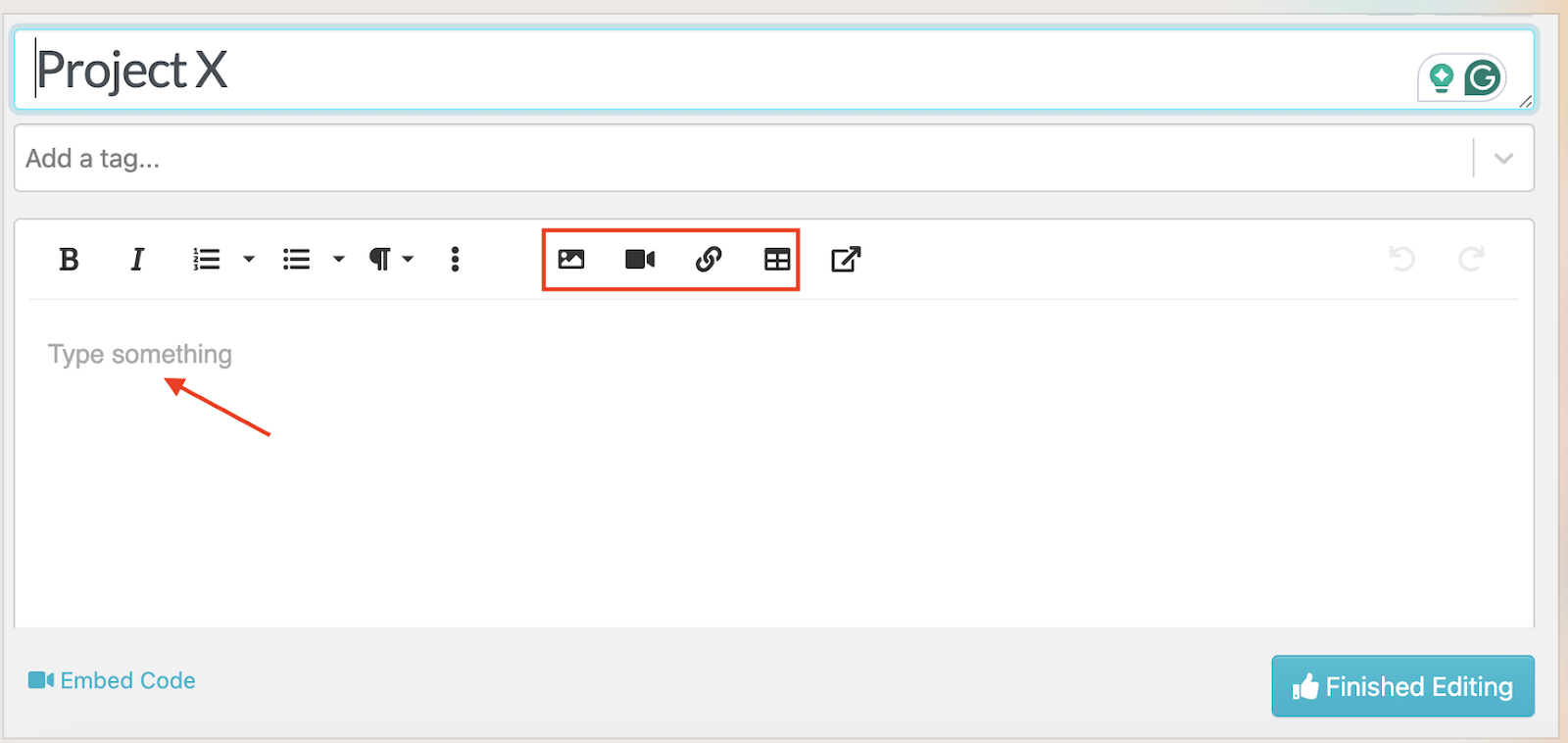
- Make real-time updates
So why SweetProcess?
Unlike traditional documentation tools, SweetProcess provides an all-in-one workflow solution that eliminates the need for multiple software tools. Your SOPs stay accessible, editable, and organized in one place.
Generate Your Project Management SOPs Automatically Using SweetAI
Writing SOPs from scratch can take hours, if not days—especially when managing multiple projects. SweetAI takes the heavy lifting off your shoulders by automatically generating structured SOPs based on project details.
You just need to input the procedure title and key details, and SweetAI will create a polished SOP in minutes.

You can refine the draft to match your team’s unique needs.

AI-powered SOP generation is essential because it:
- Reduces SOP creation time from hours to minutes
- Ensures consistency across all project workflows
- Minimizes human error by using AI-powered recommendations
Assign Tasks and Collaborate With Team Members Seamlessly
An SOP is only useful if your team can easily access and implement it. With SweetProcess, you can:
- Assign specific tasks to team members within an SOP
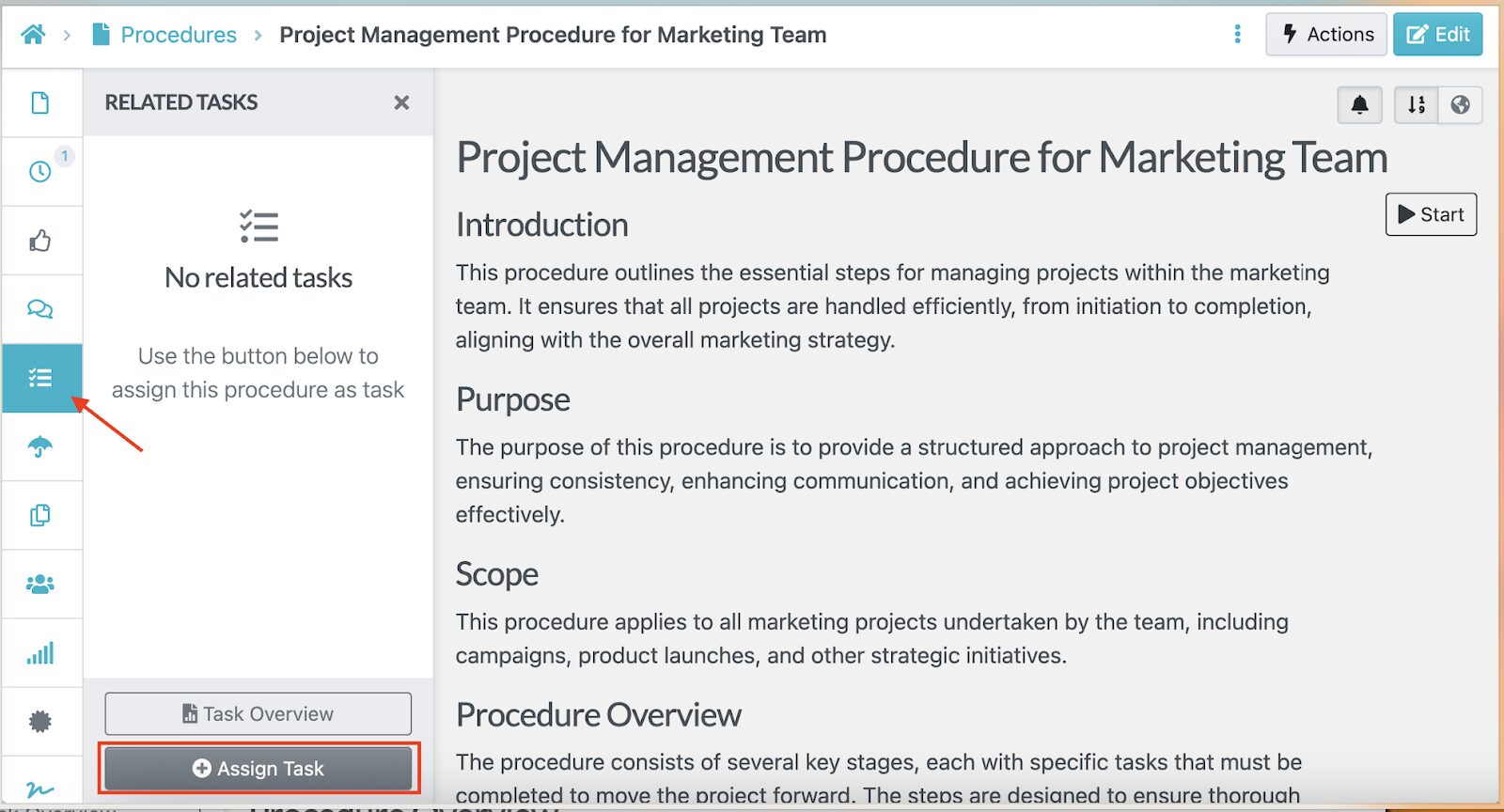
- Track progress in real time to ensure accountability
- Allow team members to leave comments, request clarifications, and update processes collaboratively
- View different versions and pick the one you need
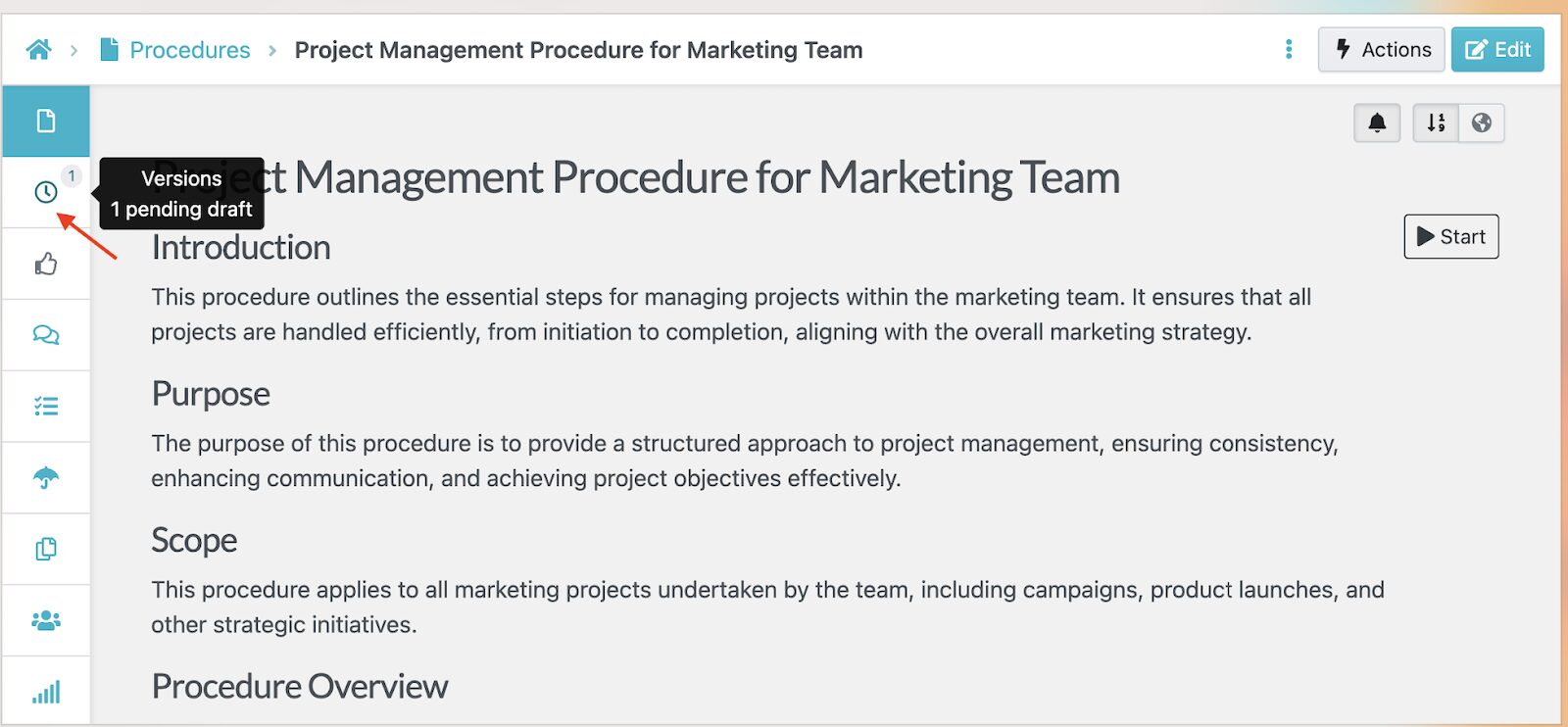
This feature is important for project managers because they can communicate with their respective team members from one platform. There is no need for multiple emails and documents, eliminating miscommunication and reducing errors.
Manage Your Project Management SOPs in One Place
After you create your SOPs, it’s vital to keep them organized. SweetProcess offers a centralized dashboard where all project SOPs are stored, categorized, and easily accessible. Everything is easily available if you need to update an existing SOP, train new employees, or ensure compliance.
You can view all your documentation and take action if you need to edit, share, or delete an SOP.
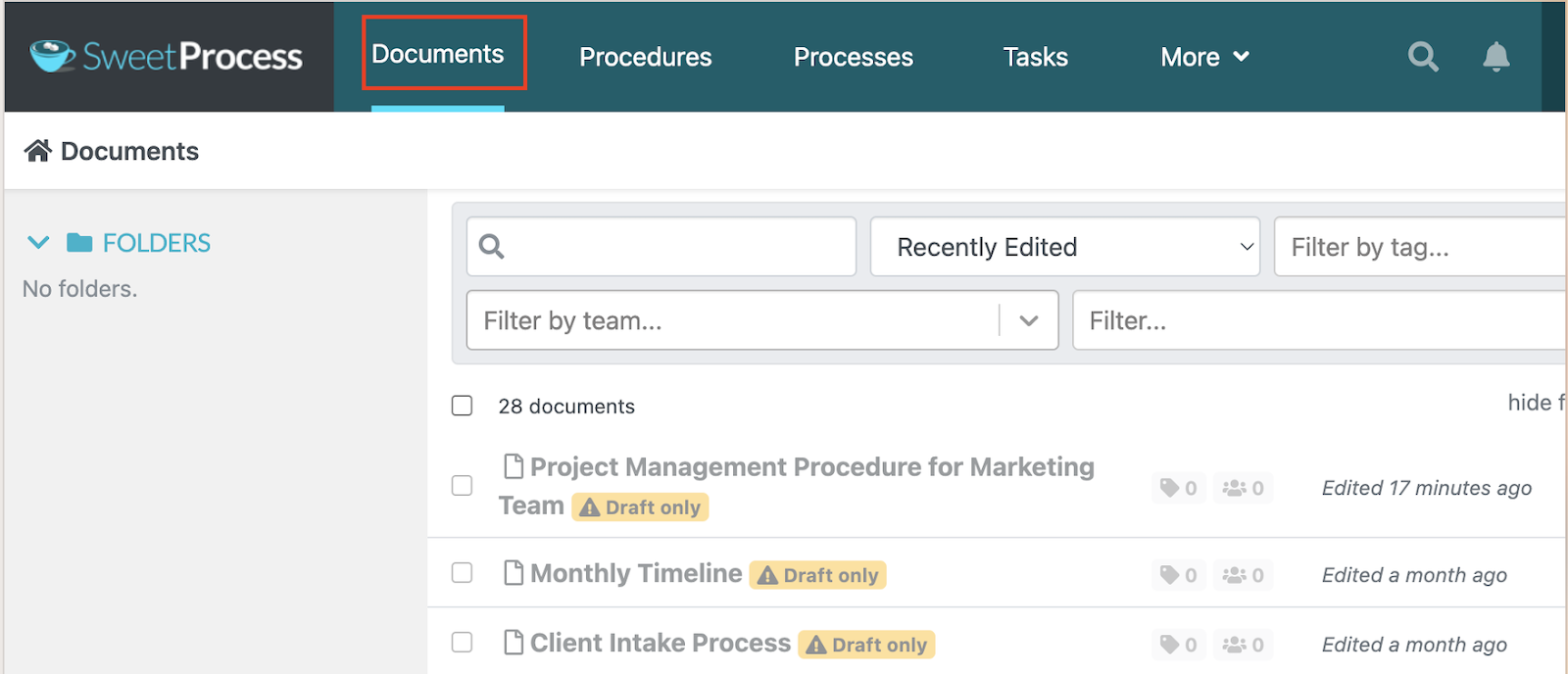
This centralized documentation makes it easier to manage multiple projects. Your team doesn’t have to spend most of their time searching for the right information. Additionally, the SOPs are securely managed with permission controls to prevent unauthorized changes.
Several businesses have used these SweetProcess features to manage their projects. One of them is DFK Hirn Newey, an accounting and consulting firm. The company faced significant challenges managing procedures and ensuring compliance in an evolving digital landscape.
As the company transitioned from paper-based processes to modern software systems, they struggled with updating SOPs. The director, Paul Fiumara, initially attempted to manage SOPs manually, but the complexity of scattered procedures made it an overwhelming task. His search for a cloud-based procedure management tool led him to SweetProcess.
Since this implementation, the company now enjoys benefits such as:
- Efficient SOP documentation: SweetProcess simplified the process of writing and maintaining procedures.
- Seamless software integration: They now document and manage multiple software applications in one place.
- Improved compliance: SweetProcess ensured all staff had access to up-to-date procedures for professional certifications.
- Centralized communication: They replaced the overwhelming email chains with a structured notice board for company-wide updates.
- Faster policy implementation: SweetProcess enabled the quick rollout of new policies and procedures, reducing training time and confusion.
The other organization is Maxwell Counters, a countertop fabrication company in Illinois. The company faced workflow inefficiencies due to scattered and outdated procedures. Employees relied on paper binders and Word documents, making it difficult to access up-to-date information.
The general manager, Austin Maxwell, sought a centralized system to streamline operations and reduce repetitive employee questions. After extensive research, he chose SweetProcess to transform the operations. Since switching to SweetProcess, the company now enjoys:
- Organized workflow documentation: They eliminated paper binders and outdated network folders, ensuring easy access to updated procedures.
- Simplified employee training: New hires quickly learned processes, reducing constant repetitive questions to managers.
- Visual and interactive SOPs: Employees referenced videos and images for complex tasks, improving understanding and execution.
- Consistent performance standards: SweetProcess ensured uniform quality in countertop installations and replacements.
- Efficient task delegation: Managers tracked responsibilities and ensured seamless operations even when employees were absent.
With SweetProcess, Maxwell Counters transformed its workflow, creating a structured and consistent system that improved productivity and reduced operational headaches.
10 Project Management SOP Templates & Examples To Inspire Your Team
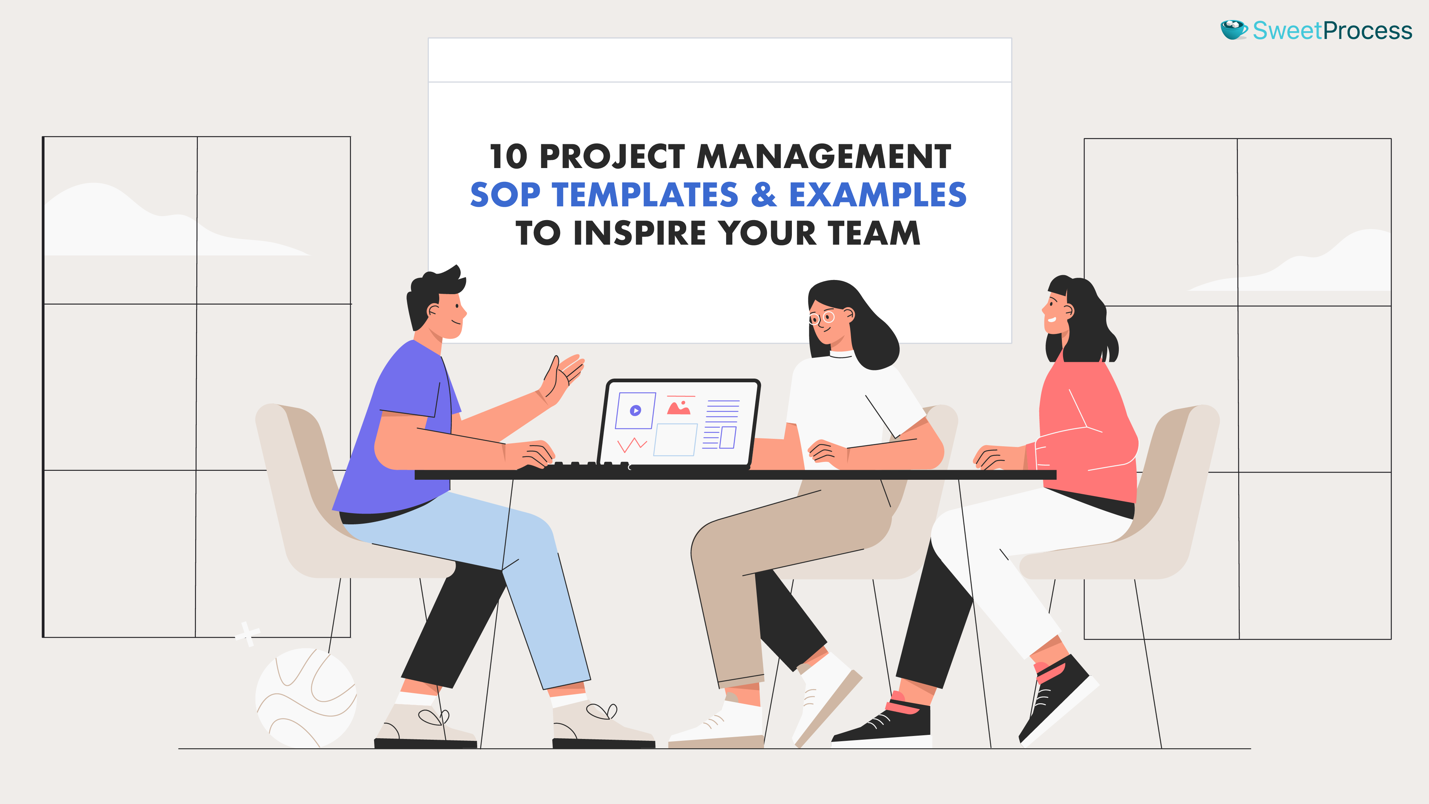
Executing a project requires SOPs to manage team communication, handle risks, and assign tasks. This structured framework keeps your team on track by providing a reference point for all project activities.
With templates, you can create your SOPs much faster. Here are 10 essential project management SOP templates that can guide your team through every stage of project execution.
Project Initiation SOP Template
The success of any project starts with proper planning. This SOP guides teams through the essential steps of project initiation, including defining the project’s goals, scope, stakeholders, budget, and timeline. It outlines how to conduct feasibility studies and secure necessary approvals before execution begins.
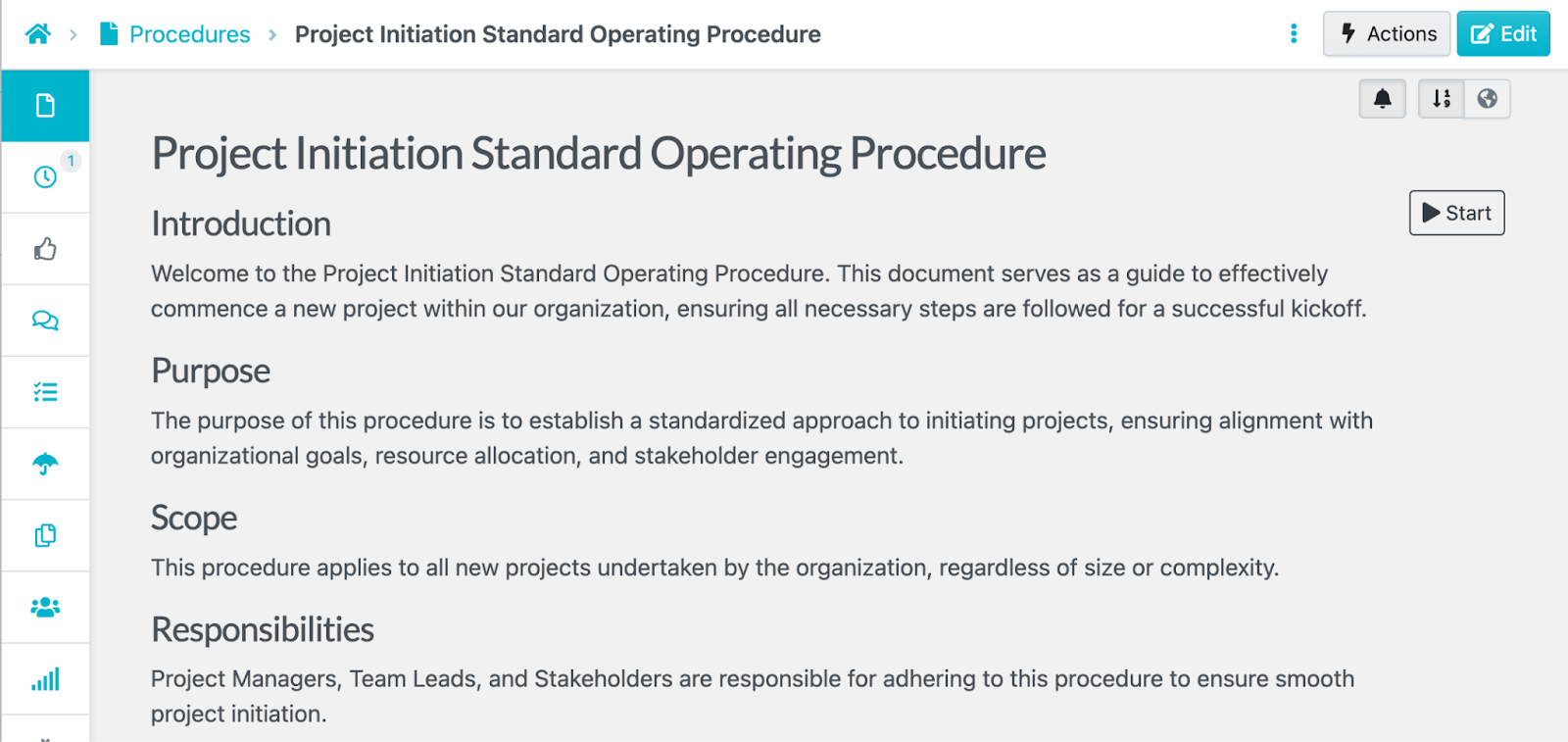
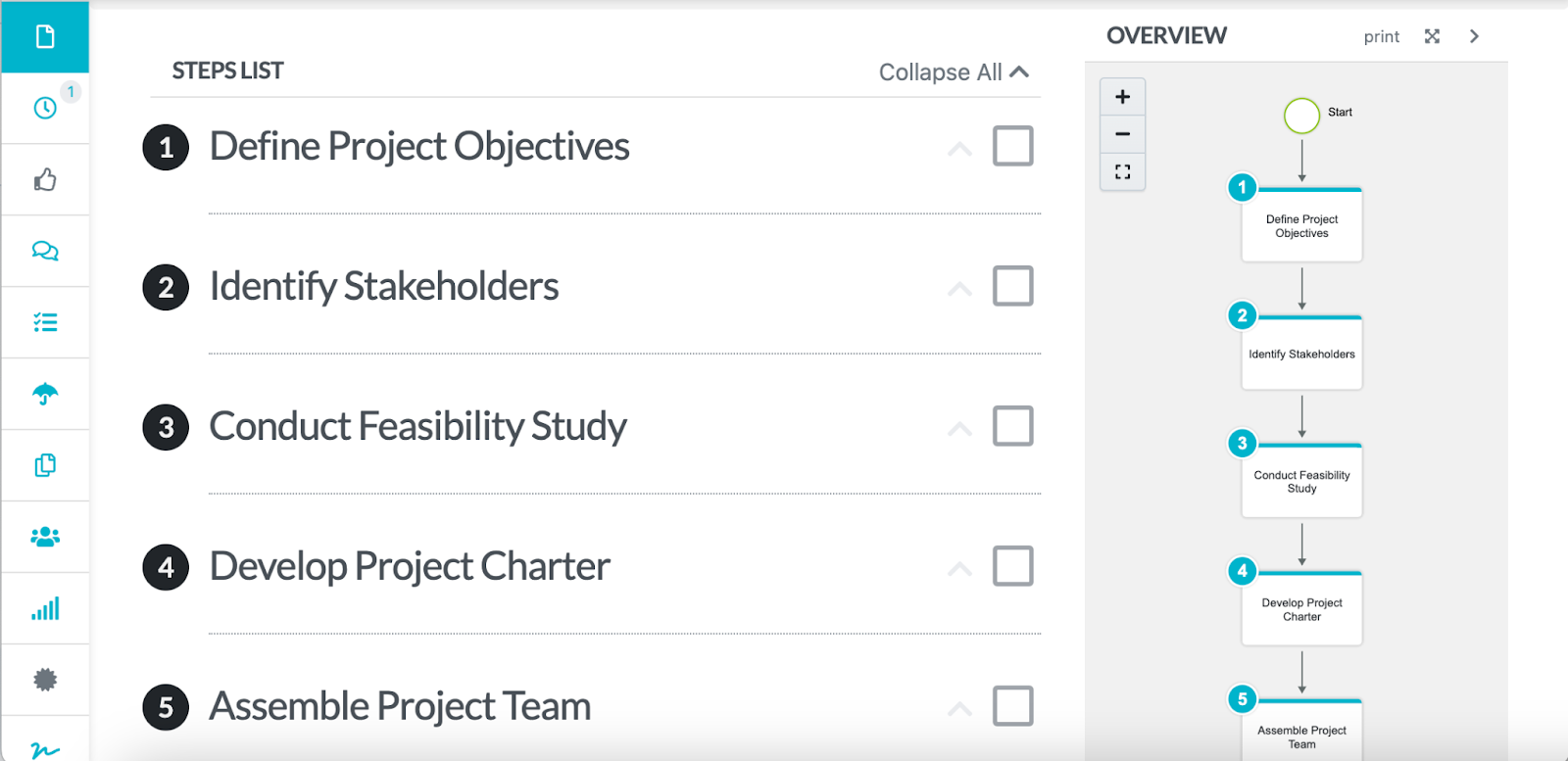
A structured project initiation ensures that all stakeholders are aligned, objectives are clear, and the foundation is strong before moving forward. It also prevents unrealistic expectations and scope creep.
Download the Project Initiation SOP Template
Task Delegation SOP Template
Your project needs proper task delegation to run smoothly. With an SOP template, you can assign tasks based on team members’ expertise, availability, and workload. It provides a structured approach to defining task priorities, deadlines, and expected outcomes while ensuring team members understand their roles.
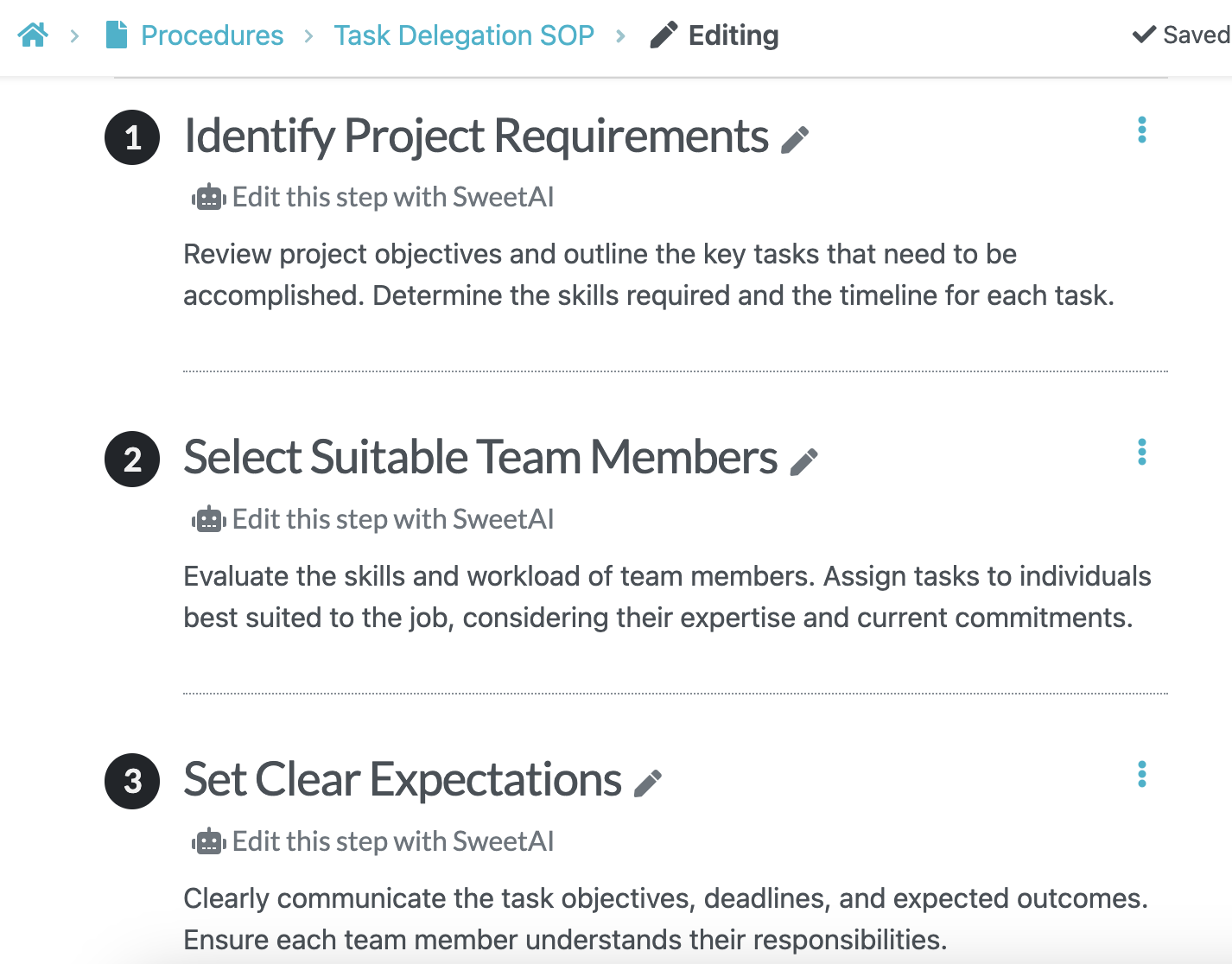
Download the Task Delegation SOP Template
Communication & Reporting SOP Template
Miscommunication within a project can lead to misunderstandings, missed deadlines, and eventual failure. You need to structure guidelines for internal and external communication to keep all stakeholders on the same page.
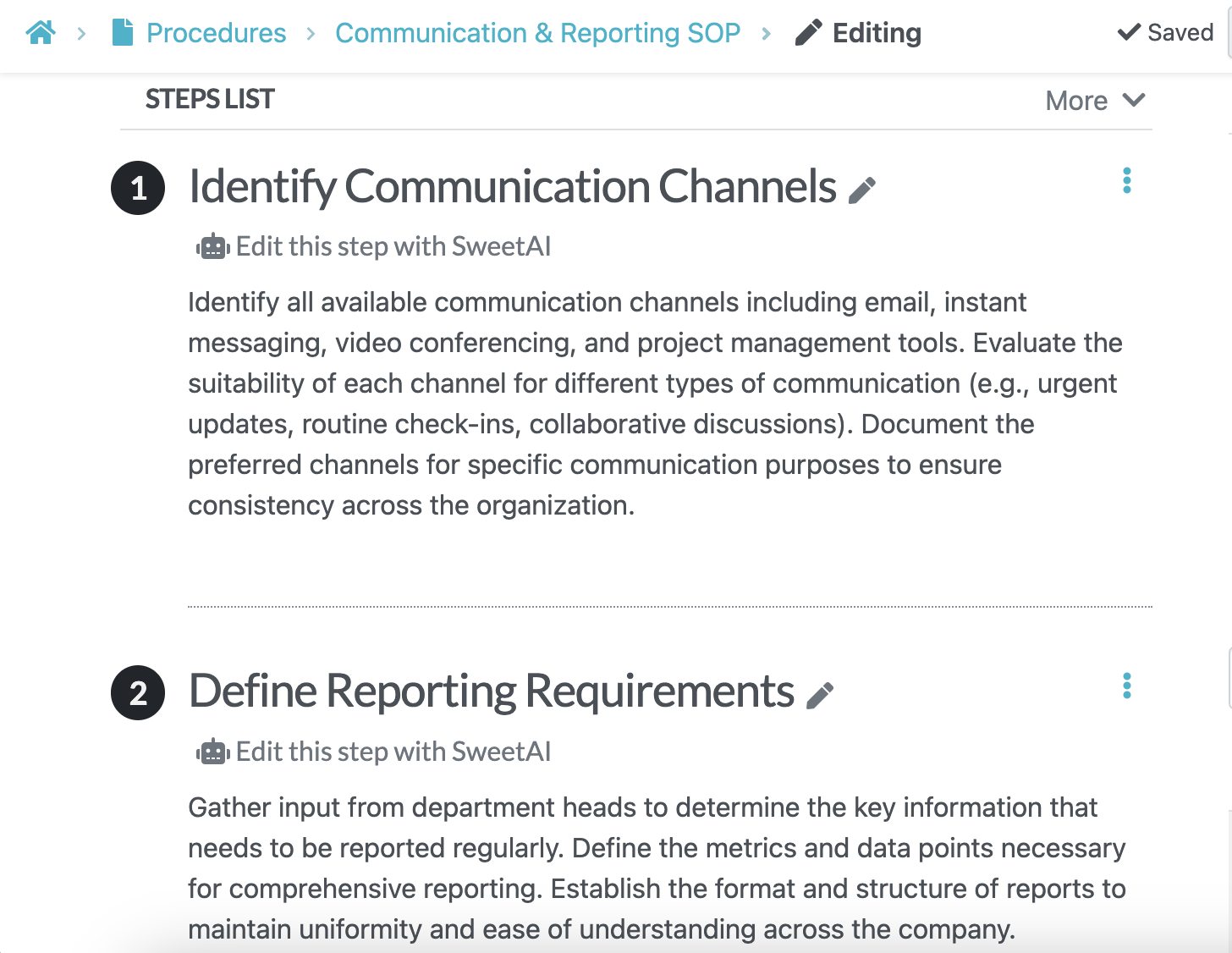
This template covers details such as meeting schedules, reporting structures, and status update formats to keep the project flowing smoothly. With a clear communication plan, you can determine the reporting standards to minimize disruptions.
Download the Communication and Reporting SOP Template
Risk Management SOP Template
Every project has risks. However, if you proactively identify and address them, you can prevent costly mistakes. You can use your SOP to outline the process for operational risk identification, assessment, prioritization, and mitigation strategies. It also includes a risk log to track potential threats and their impact on the project.
A structured risk management approach helps teams respond effectively to challenges and minimizes project disruptions.
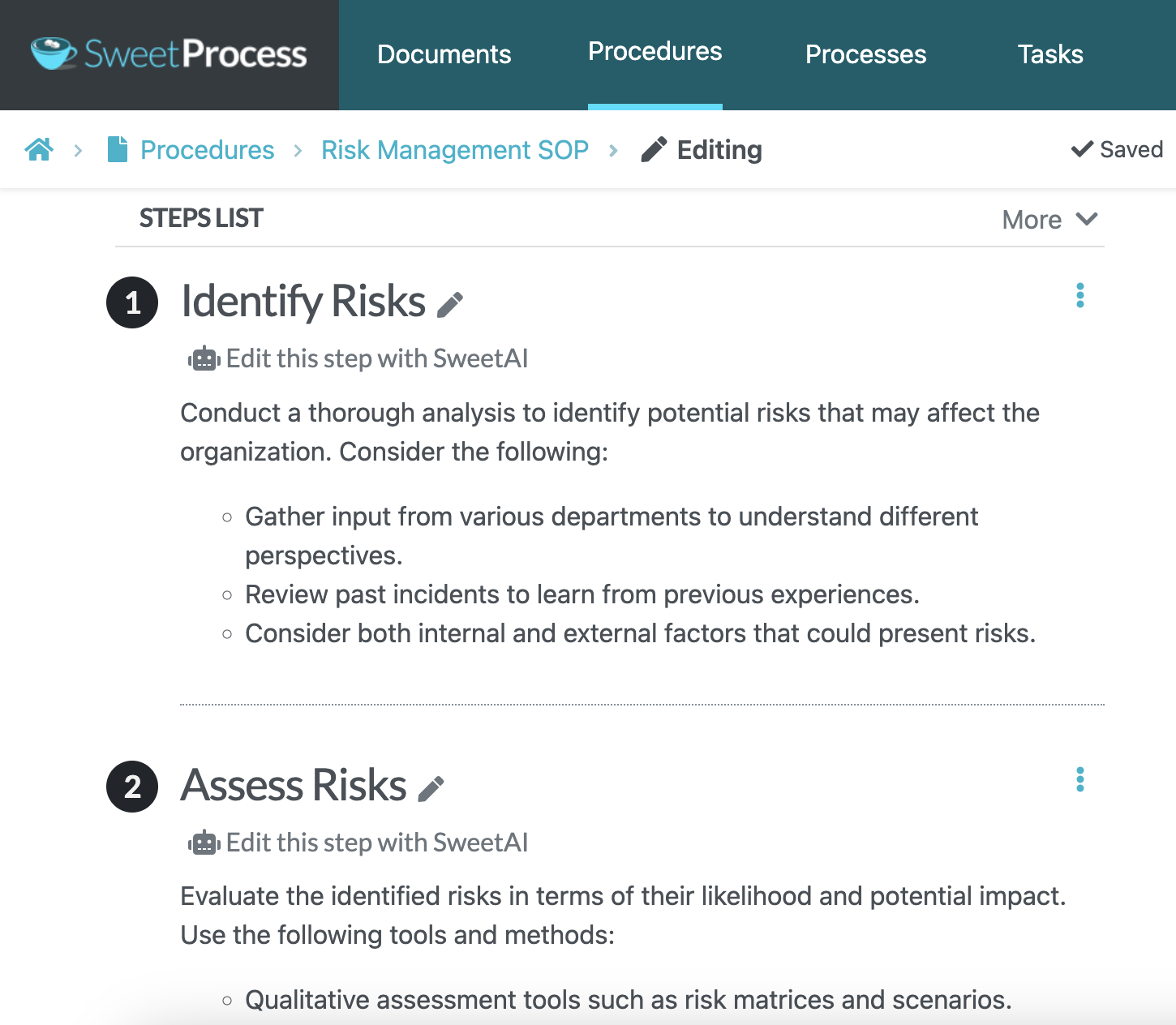
Download the Risk Management SOP Template
Project Closure SOP Template
Closing a project involves more than just wrapping up tasks. This SOP ensures that teams properly document lessons learned, finalize deliverables, and obtain approvals. It also outlines the steps for conducting a postmortem analysis to assess what worked well and what can be improved.
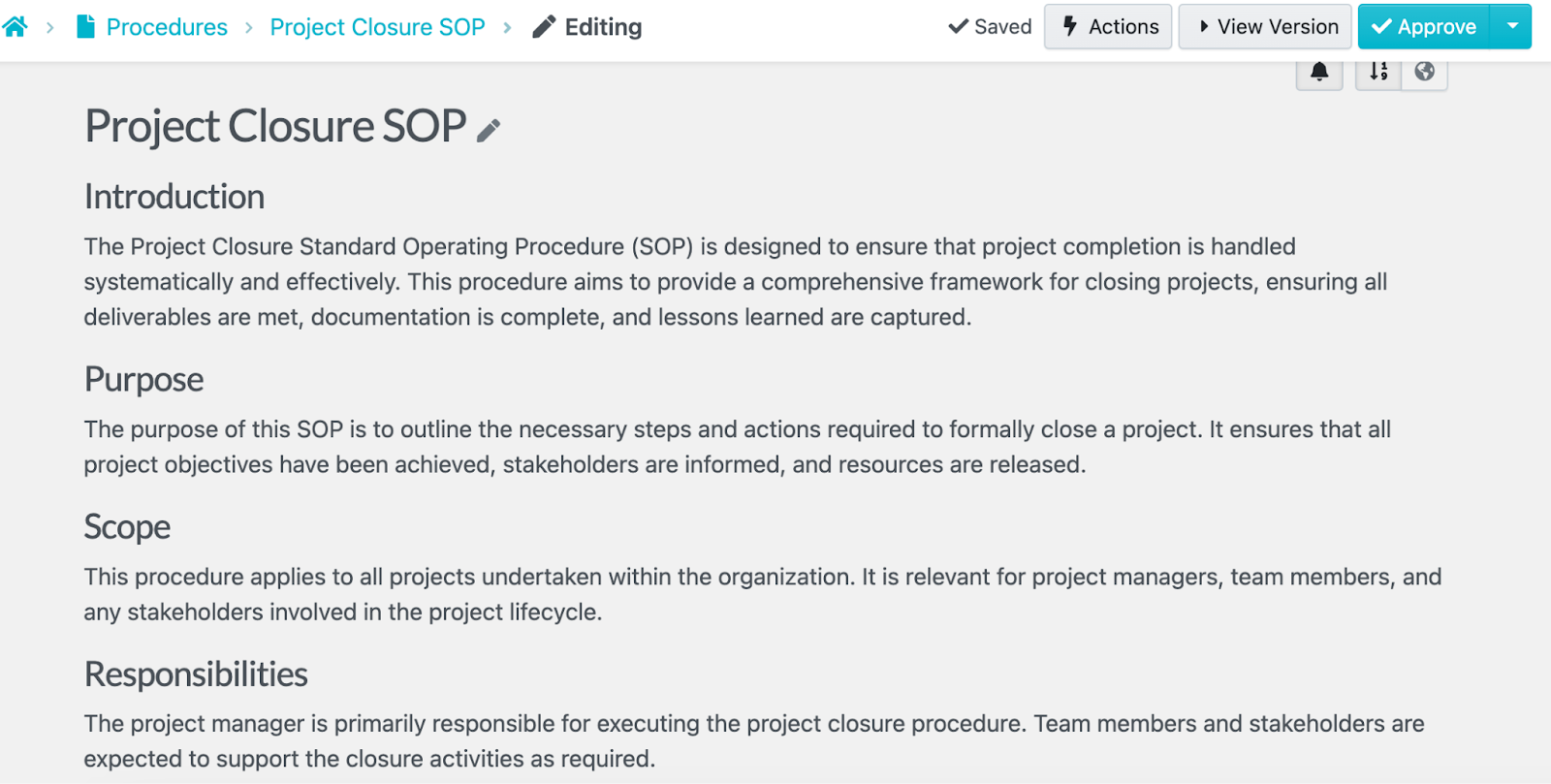
A structured closure process ensures that teams document key insights and set a precedent for future projects.
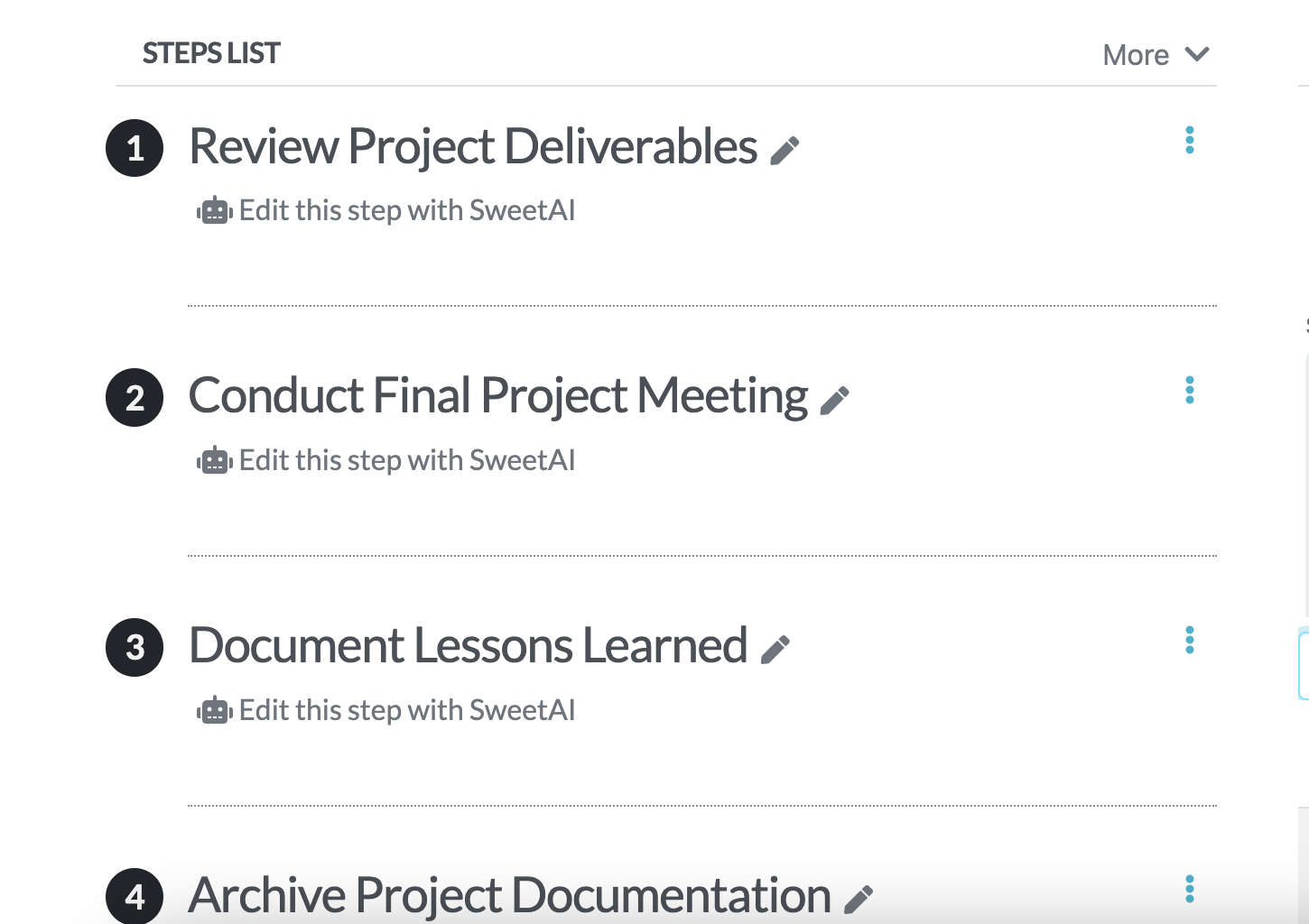
Download the Project Closure SOP Template
Budgeting & Cost Management SOP Template
Budget overruns are a common challenge in project management. Projects can easily exceed costs without effective budget management, leading to financial losses and reduced profitability.
This SOP provides a framework for cost estimation, tracking expenses, managing financial resources, and handling budget changes. It can also include methods for cost control.
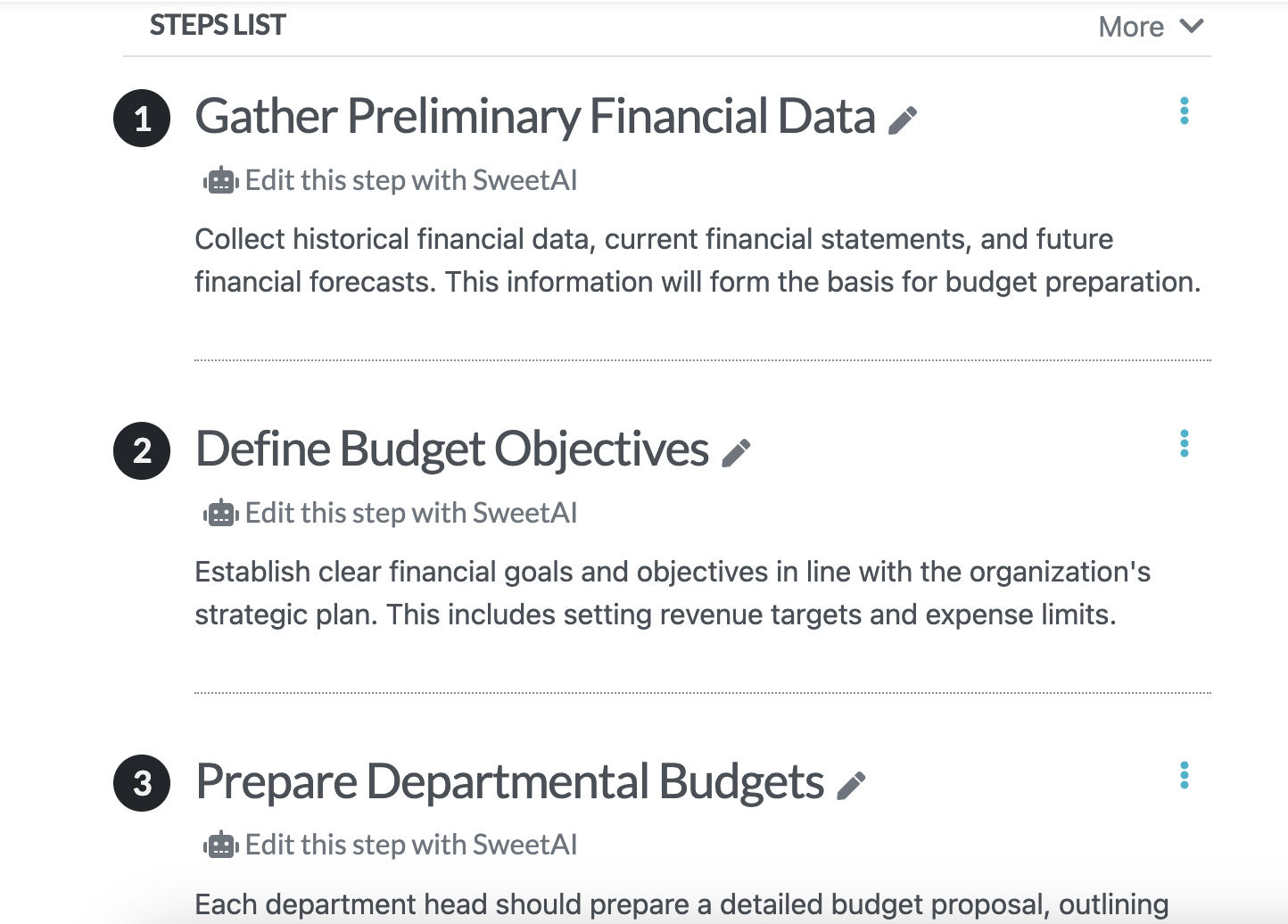
When you have a well-defined budgeting process, your funds are allocated efficiently, and any financial risks are addressed before they escalate.
Download the Budgeting & Cost Management SOP Template
Quality Assurance SOP Template
All projects have to meet a certain standard. Otherwise, you might encounter client dissatisfaction and reputational damage.
If you have a quality assurance SOP, you can indicate the inspection criteria, testing procedures, and corrective actions to ensure that deliverables meet the required standards. This template also covers the guidelines for continuous improvement and compliance with industry regulations.
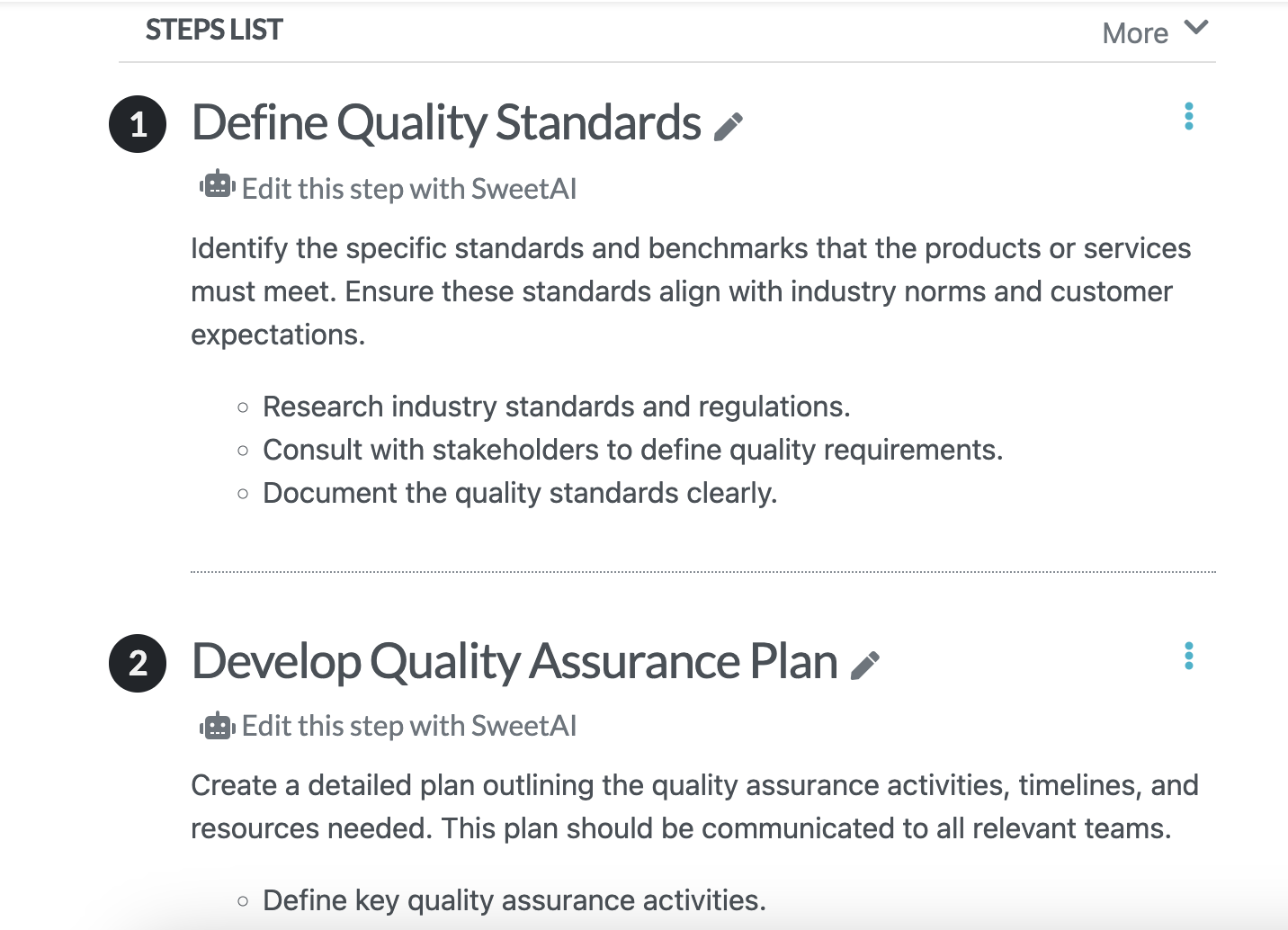
Download the Quality Assurance SOP Template
Change Management SOP Template
Projects often evolve, and changes need to be handled effectively. With this SOP, you can outline how to request, evaluate, approve, and implement changes with minimal disruption. It also includes a structured process for documenting change requests and communicating changes to stakeholders.
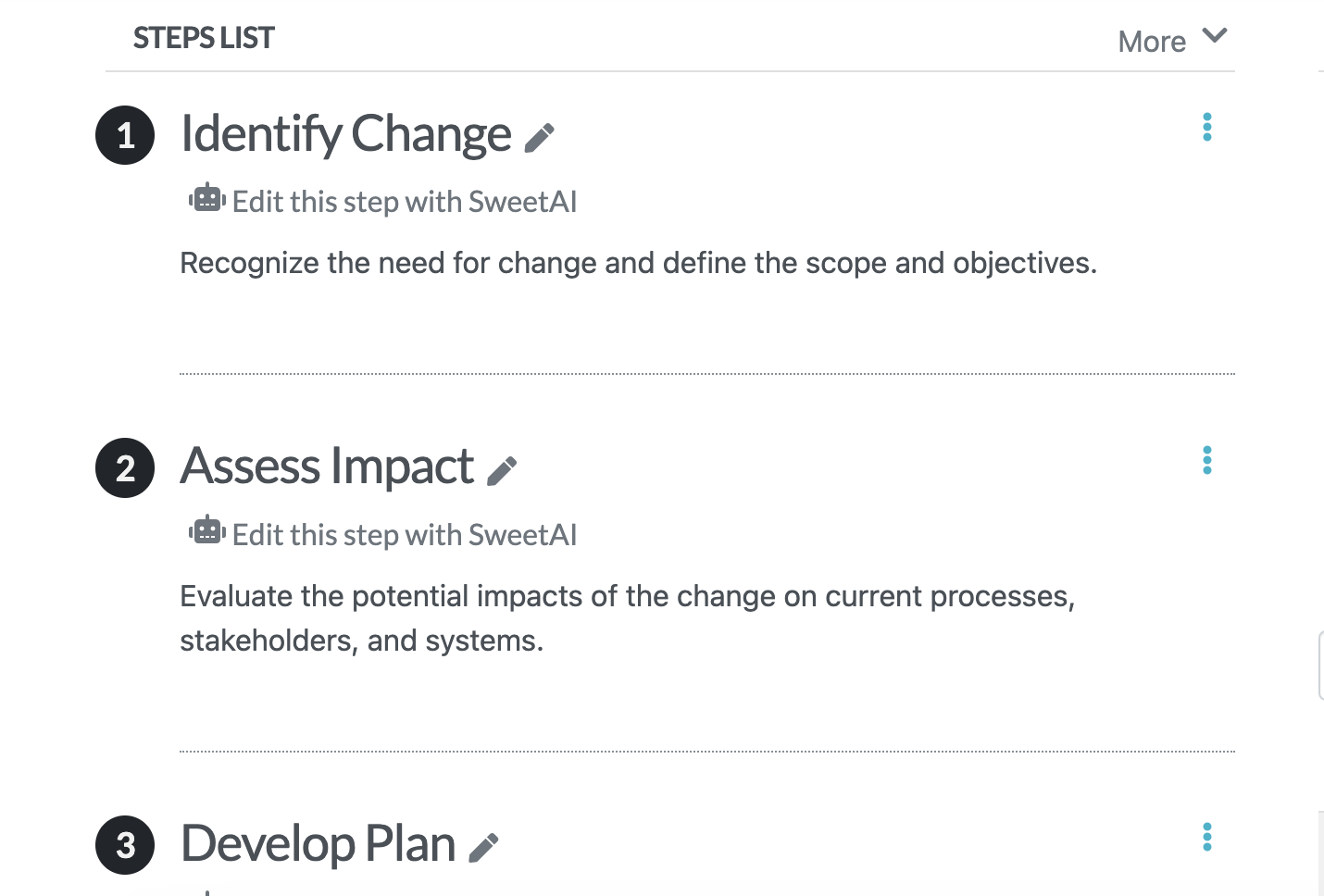
A well-structured change management process helps teams adapt while keeping projects on track.
Download the Change Management SOP Template
Stakeholder Management SOP Template
How do you keep all your stakeholders satisfied? Simple—by having a structured guideline on how to align expectations. A stakeholder management SOP template outlines how your company will identify key stakeholders, set communication plans, and address their concerns.
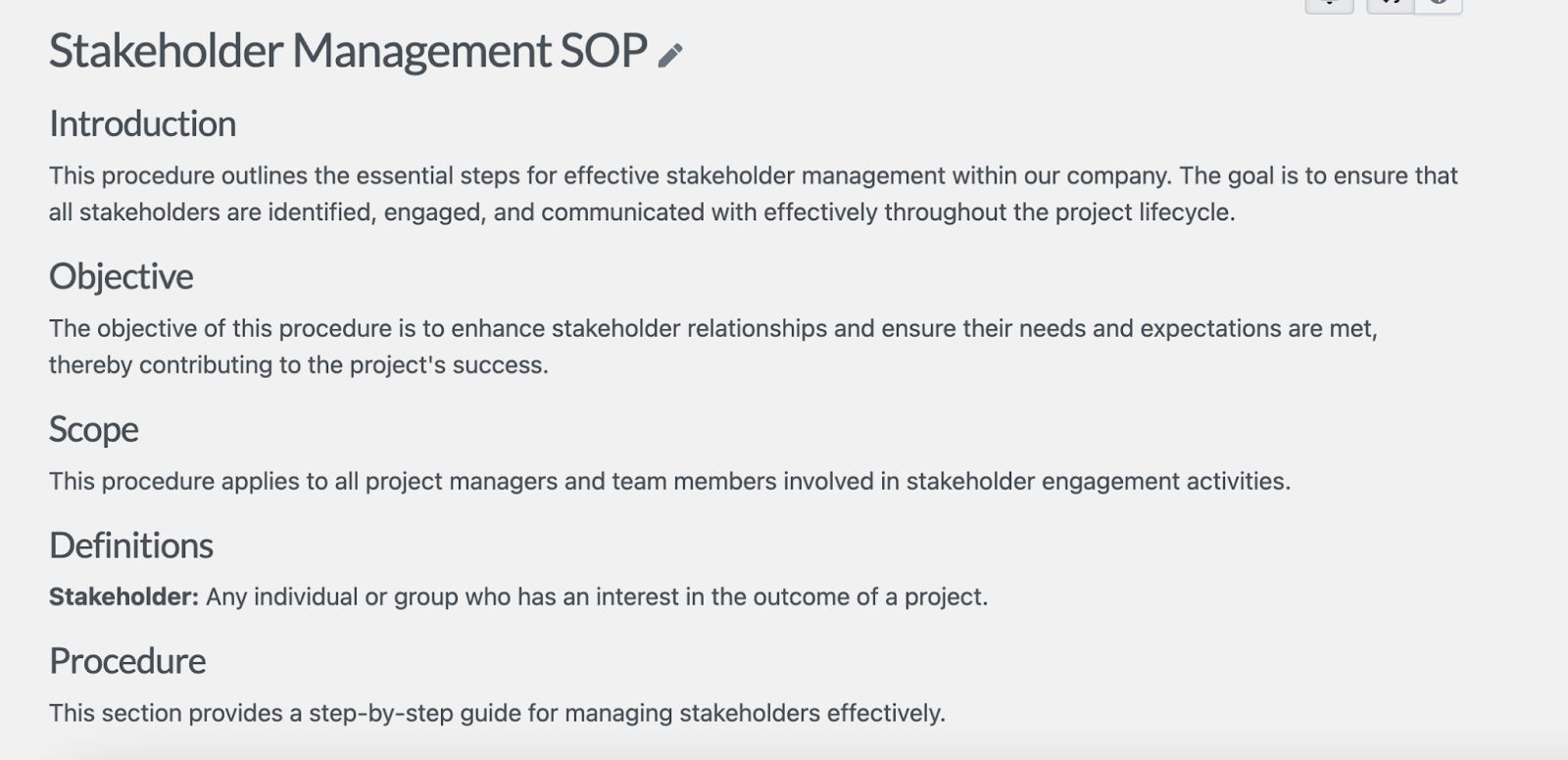
Establishing a structured approach to stakeholder management ensures better collaboration.
Download the Stakeholder Management SOP Template
Project Review & Evaluation SOP Template
Evaluating project performance helps you improve future processes. You can use this SOP template to conduct post-project reviews, gather feedback, analyze key performance metrics, and document lessons learned.

Additionally, you can outline how to compile final reports and share insights with stakeholders.
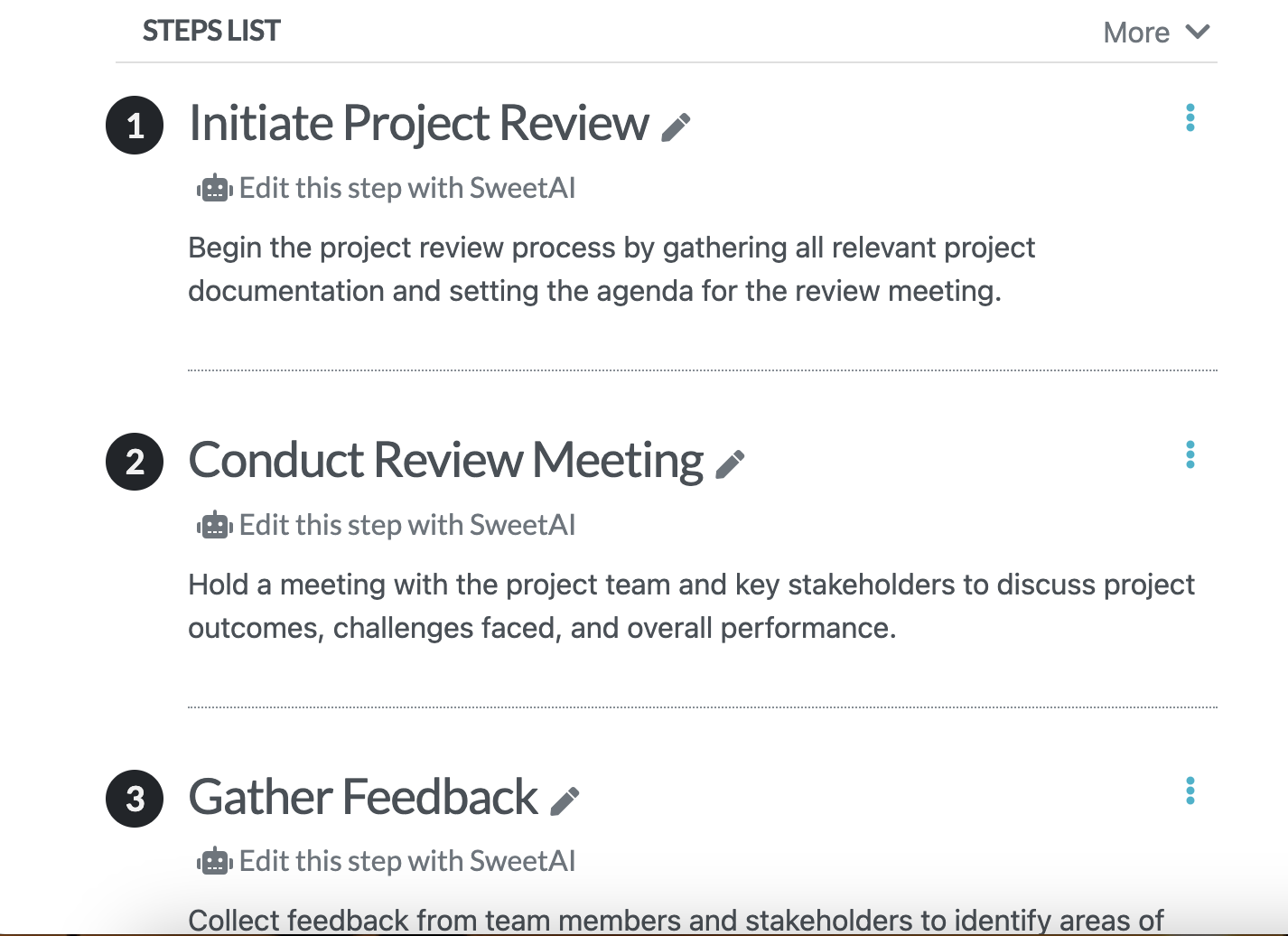
Without proper evaluation, teams may repeat mistakes and miss opportunities for process improvement.
Download the Project Review & Evaluation SOP Template
Best Practices & Tips for Creating and Adopting a Productive Project Management SOP
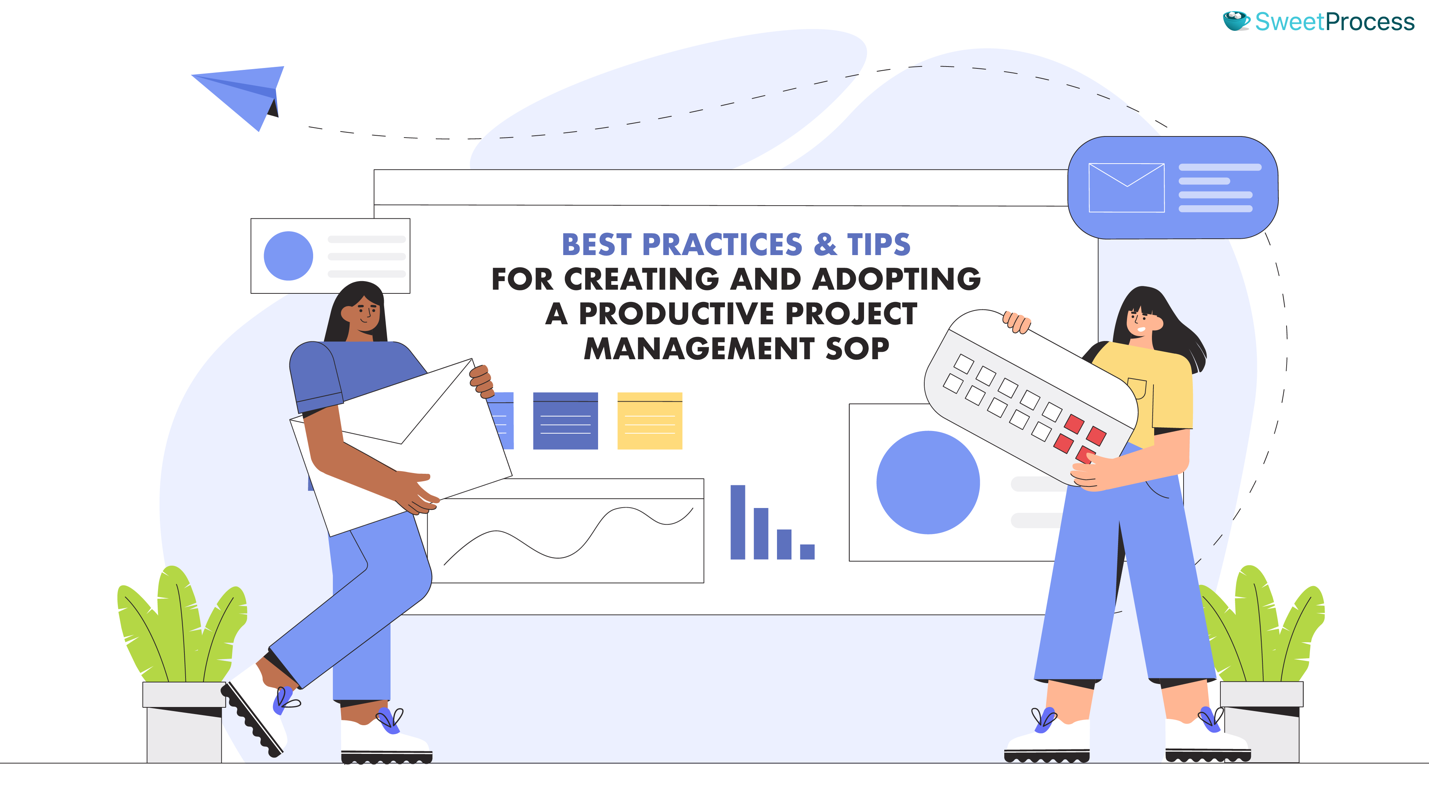
Creating a solid SOP for project management isn’t just about documenting processes. You also need clarity and consistency across teams. So, how do you create well-rounded SOPs? Here are some essential best practices:
Write in Clear Language
Ever tried following a set of instructions that felt vague? Confusing language can turn an SOP into a roadblock rather than a helpful guide. The primary goal of an SOP is to create a clear and structured roadmap for executing tasks, but if employees struggle to interpret the instructions, it loses its effectiveness.
Matthew McCutchen – the Project Manager at Stantec, emphasizes the significance of standardized procedures. According to him:
“The foundation of an SOP for project management office (PMO) governance begins with clarifying the PMO’s core identity and strategic intent. This involves determining whether the PMO functions as a supporting, controlling, or directive entity.”
This highlights the importance of clarity. SOPs should define processes, roles, and responsibilities in a way that leaves no room for misinterpretation.
To ensure clarity, follow these best practices:
- Using simple language: Avoid jargon and overly technical terms unless absolutely necessary.
- Being direct: Use short, precise sentences to outline steps. You can also use a step-by-step approach, listing each action to eliminate ambiguity.
- Defining terms where necessary: If technical jargon is unavoidable, include a glossary or definition section to ensure everyone understands key terms.
When SOPs are written in a way that everyone, from new hires to senior employees, can understand and follow, they become powerful tools that enhance efficiency.
Incorporate Visuals
Imagine assembling new furniture with just text instructions. Frustrating, right? SOPs work the same way. Text-heavy SOPs can feel overwhelming and difficult to navigate. Incorporating visuals makes processes easier to follow. Here are some of the visuals you can include:
- Flowcharts to map out decision-making processes
- Screenshots for step-by-step guides
- Videos to demonstrate complex tasks in real time
For instance, instead of writing a long paragraph explaining how to submit a project update in your project management software, you can include a screenshot of the submission button, annotated with arrows and labels. This speeds up execution.
Maintain Consistency
Let’s say, in one SOP, you use “Task Owner” and in another, you refer to the same role as “Project Leader.” This can become confusing. It’s vital to use consistent terminology, formatting, and structure to avoid mistakes.
When teams struggle to understand what an SOP is referring to, they either waste time clarifying or make incorrect assumptions, both of which affect efficiency.
To maintain this consistency, use a standardized SOP template that follows the same format and is easier to read and navigate. You can also structure your SOPs the same way and stick to the same terminologies for roles, processes, and documents across the projects.
This way, employees will know exactly where to find the information they need, reducing employee onboarding and training time.
Notify Everyone
What’s the point of crafting the perfect SOP if no one knows it exists? Many SOPs fail simply because teams aren’t aware of updates. Employees continue working using old methods, leading to misalignment and noncompliance.
Here are some ways to ensure everyone is notified:
- Use company-wide communication channels: Announce new or updated SOPs through email or company channels to ensure visibility.
- Hold quick meetings or briefings: Reinforce updates and allow employees to ask questions.
- Tag relevant teams in project management tools: If your company uses tools like SweetProcess, create an update and tag the affected teams.
- Share updated SOPs in a central repository: Ensure that employees know exactly where to find the latest version.
As project manager Kyle Nitchen puts it:
“An SOP is a guideline, not a straitjacket. It should help people do things faster, answer questions, remove uncertainty, align and empower, reduce variance and errors, and most importantly, free people up for high-impact work—not force them into something that will never fit comfortably.”
Making sure everyone is informed about SOPs and understands their purpose prevents confusion and ensures they serve as a helpful guide rather than a rigid set of rules.
Offer Training
Even the best-written SOPs are ineffective if employees don’t know how to use them. Many companies mistakenly assume that sharing an SOP is enough, but providing SOP training ensures employees understand the procedures and execute them correctly. Incorporating practical SOP examples during training sessions can significantly enhance comprehension by illustrating real-world applications of the guidelines.
You can provide effective SOP training by:
- Hosting interactive walk-throughs: Walk teams through SOPs step by step, allowing them to ask questions and get hands-on experience.
- Creating self-paced learning resources: Prerecorded video tutorials, FAQs, and quizzes help employees learn at their own pace.
- Running periodic refresher sessions: Even seasoned employees need occasional training, especially when updates occur.
Encourage Feedback
The people using the SOPs daily should have a say in refining them. Employees will encounter real-world challenges that weren’t considered when writing the SOP. Their feedback is invaluable in making the SOP more practical and effective.
As a project manager, you can create a feedback loop by setting up a dedicated channel for employees to suggest improvements. Once you have this information, you can review the common challenges and rewrite the SOPs if necessary. In addition, it’s advisable to have more comprehensive SOP review sessions that allow employees to voice concerns and suggest updates.
Review Regularly
How many times have you stumbled upon an outdated company document that no one has looked at for years? SOPs should evolve with your business needs. If an SOP isn’t reviewed regularly, employees may follow outdated steps, leading to inefficiencies.
To keep SOPs relevant:
- Review them quarterly or biannually to ensure they remain aligned with current workflows.
- Designate individuals responsible for updating and maintaining specific SOPs.
- If new software, policies, or regulations are introduced, update the SOPs accordingly.
The Project Management Methodology for Software Projects podcast affirms the need for continuous evaluation, sharing his personal experience of taking over a troubled project.
The discussion emphasizes the importance of having clear methodologies and procedures, reinforcing that SOPs must be regularly assessed and refined to remain effective.
Regular reviews ensure that SOPs are always aligned with evolving processes, helping teams maintain efficiency and effectiveness.
Create and Manage Your Project SOPs in One Place

You can achieve successful project management by executing every step consistently. Creating a well-defined SOP is the first step in achieving this. It takes the guesswork out of daily operations, helping teams stay aligned and minimize errors. When project workflows are clear, team members can focus on delivering quality results rather than wasting time figuring out what comes next.
Instead of juggling scattered documents and outdated processes, why not simplify everything with SweetProcess? Our easy-to-use interface allows you to create, update, and manage SOPs in one centralized location, keeping your team on the same page at all times.
